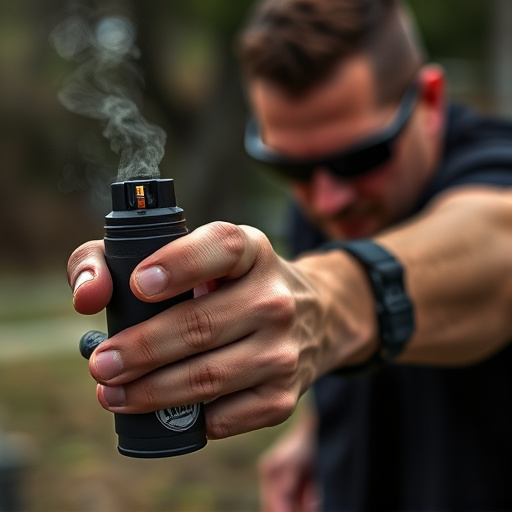Pepper spray, a self-defense tool, uses capsaicin to temporarily disable attackers by targeting facial pain receptors. To neutralize pepper spray effectively, civilians should aim for sensitive areas like eyes and nose at close range. Post-use, proper ventilation, washing with soap and water for 15 minutes is vital to minimize exposure and discomfort. Staying low, moving slowly away, and using eye protection helps mitigate effects. Understanding legal regulations and proper training are crucial for safe use of pepper spray neutralizers on the face.
“In today’s unpredictable world, civilians seeking personal protection against physical threats are increasingly turning to inflammatory sprays as a powerful defense mechanism. Known for their ability to neutralize pepper spray on the face and disrupt an attacker’s senses, these tools offer a layer of security in various scenarios.
This article explores ‘understanding pepper spray’ as a civilian’s defense tool, delving into its science, effectiveness against attacks, and the crucial legal and safety considerations surrounding its use.”
- Understanding Pepper Spray: A Civilian's Defense Tool
- The Science Behind Neutralizing Pepper Spray
- Effective Strategies for Countering Pepper Spray Attacks
- Legal and Safety Considerations for Civilian Use of Neutralizing Sprays
Understanding Pepper Spray: A Civilian's Defense Tool
Pepper spray, a powerful tool for civilian self-defense, has become increasingly popular among those seeking effective personal protection. Unlike traditional mace, pepper spray is designed to neutralize an assailant by causing temporary blindness and intense irritation, allowing users to escape potentially dangerous situations. The active ingredient, capsaicin, is extracted from chili peppers and delivers a strong inflammatory response when in contact with the eyes, skin, or respiratory system.
For civilians considering pepper spray as a defense mechanism, understanding how to properly use and manage its effects is crucial. When faced with an attacker, spraying directly into the face at close range can quickly disable them, providing an opportunity for escape. However, it’s essential to remember that pepper spray should be used as a last resort, and users must also take precautions to minimize exposure to the spray themselves. Effective techniques include aiming for the eyes, nose, and mouth of the assailant and ensuring proper ventilation after use. Proper neutralization involves washing the affected area with soap and water immediately after contact.
The Science Behind Neutralizing Pepper Spray
The effectiveness of neutralizing pepper spray lies in its ability to disrupt the sensory system and temporarily incapacitate an attacker. When sprayed into the eyes and face, capsaicin, the active ingredient, binds to pain receptors, causing intense irritation and inflammation. This reaction leads to temporary blindness, reduced visibility, and excessive tearing, giving the user precious seconds to escape or defend themselves.
The science behind neutralizing pepper spray focuses on counteracting these effects. Formulations are designed to neutralize the capsaicin, reducing its potency and minimizing discomfort. Some modern sprays use natural enzymes or synthetic compounds that break down the chemical bond of capsaicin, ensuring it no longer binds to receptors. This rapid neutralization allows users to recover faster, providing an essential window for self-defense and safety in civilian protection scenarios.
Effective Strategies for Countering Pepper Spray Attacks
When facing a pepper spray attack, the first step in self-defense is to neutralize pepper spray on the face. The eyes are particularly vulnerable, so immediately cover them with your hands or any available object to protect against the stinging and burning sensation. This protective action is crucial as it buys you time to formulate a strategy.
To effectively neutralize pepper spray, stay low to the ground, as the wind can carry the spray upwards. Move slowly and steadily away from the attacker, while trying to maintain visibility through your protective eyewear or any other eye protection. Once in a safe location, wash your face with cold water for at least 15 minutes to dilute and remove the chemical irritants. Remember, staying calm and utilizing these immediate countermeasures can significantly aid in mitigating the effects of pepper spray.
Legal and Safety Considerations for Civilian Use of Neutralizing Sprays
When considering the civilian use of inflammatory spray, or neutralizing sprays designed to counteract pepper spray, it’s crucial to understand the legal and safety implications. In many regions, the possession and use of such sprays are regulated, with strict guidelines on who can buy, carry, and deploy them. Civilians must ensure they operate within these legal boundaries to avoid prosecution.
Safety is another paramount concern. Neutralizing pepper spray on the face requires careful handling and understanding of its effects. Misuse or deployment in inappropriate settings could lead to injury or unintended consequences. Therefore, thorough training and familiarity with the product’s functionality and limitations are essential before considering its civilian protection use.
In conclusion, understanding how to neutralize pepper spray effectively is a valuable skill for civilians seeking protection. By grasping the science behind its action and adopting appropriate counter-strategies, individuals can better defend themselves in potential attacks. However, it’s crucial to navigate legal boundaries and prioritize safety when considering civilian use of neutralizing sprays, ensuring responsible and informed usage. Remember, knowledge is the first step towards protecting yourself and your community from inflammatory spray assaults.
